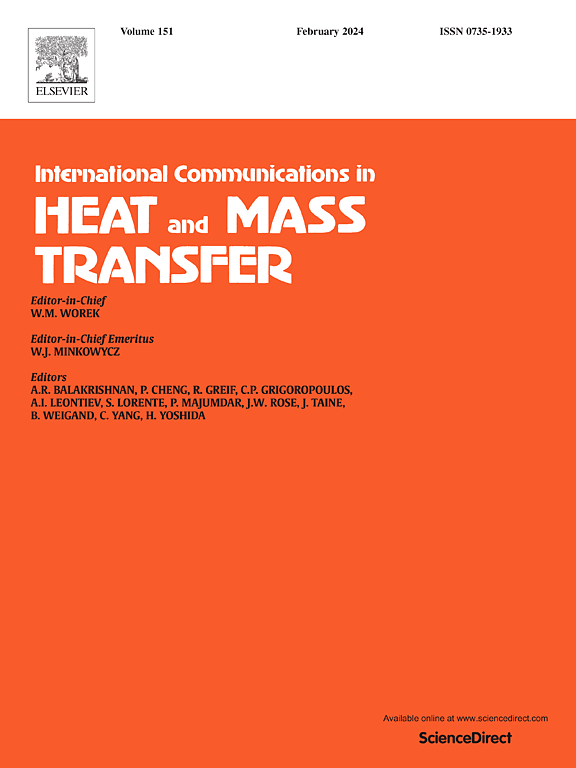不同外环冷却空气喷注条件下超大槽叶尖间隙流动及换热特性研究
IF 6.4
2区 工程技术
Q1 MECHANICS
International Communications in Heat and Mass Transfer
Pub Date : 2025-05-13
DOI:10.1016/j.icheatmasstransfer.2025.109057
引用次数: 0
摘要
考虑外环冷却空气和超大槽深的耦合作用,对低热负荷涡轮动叶间隙泄漏进行了数值研究。研究了六种周向/轴向冷却空气配置和六种槽深。结果表明,与不加外环冷却空气相比,加外环冷却空气时叶栅总压损失分别增加了1.36%、6.73%、3.62%、8.37%和13.43%。导致总泄漏损失增加的主要原因是轴向外环冷却空气,而周向外环冷却空气是加剧叶尖努塞尔数(Nu)的关键因素。周向外环冷却空气降低了75% ~ 95%叶片高度的总压损失,轴向外环冷却空气降低了95% ~ 100%叶片高度的总压损失,但加剧了75% ~ 95%叶片高度的总压损失。周向组合式轴向外环冷却空气有效地降低了轴向外环冷却空气造成的泄漏损失,可降低高达4.1%。同时,由于轴向外环和周向外环冷却空气的分离,叶尖的热负荷得到了加强。本文章由计算机程序翻译,如有差异,请以英文原文为准。
Investigation on clearance flow and heat transfer characteristics of ultra-large grooved blade tips under different outer ring cooling air injection
This study numerically investigated rotor blade clearance leakage in a low heat load turbine, considering coupled effects of outer ring cooling air and ultra-large groove depth. Six circumferential/axial cooling air configurations and six groove depths were investigated. The results indicate that the total pressure loss of the cascade increases by up to 1.36 %, 6.73 %, 3.62 %, 8.37 % and 13.43 % in the five different outer ring cooling air cases compared with that without outer ring cooling air. The primary reason contributing to the rise in overall leakage loss is the axial outer ring cooling air, and circumferential outer ring cooling air is the key factor to aggravating the Nusselt number (Nu) on blade tip. Circumferential outer ring cooling air decreases the total pressure loss in 75 % ∼ 95 % blade height, and axial outer ring cooling air reduces the total pressure loss in 95 % ∼ 100 % blade height, but aggravates the total pressure loss in 75 % ∼ 95 % blade height. Circumferential combined axial outer ring cooling air effectively decreases the leakage loss caused by axial outer ring cooling air, which can be reduced by up to 4.1 %. Meantime, the thermal load of the blade tip caused by separate circumferential and axial outer ring cooling air is strengthened.
求助全文
通过发布文献求助,成功后即可免费获取论文全文。
去求助
来源期刊
CiteScore
11.00
自引率
10.00%
发文量
648
审稿时长
32 days
期刊介绍:
International Communications in Heat and Mass Transfer serves as a world forum for the rapid dissemination of new ideas, new measurement techniques, preliminary findings of ongoing investigations, discussions, and criticisms in the field of heat and mass transfer. Two types of manuscript will be considered for publication: communications (short reports of new work or discussions of work which has already been published) and summaries (abstracts of reports, theses or manuscripts which are too long for publication in full). Together with its companion publication, International Journal of Heat and Mass Transfer, with which it shares the same Board of Editors, this journal is read by research workers and engineers throughout the world.

 求助内容:
求助内容: 应助结果提醒方式:
应助结果提醒方式:


